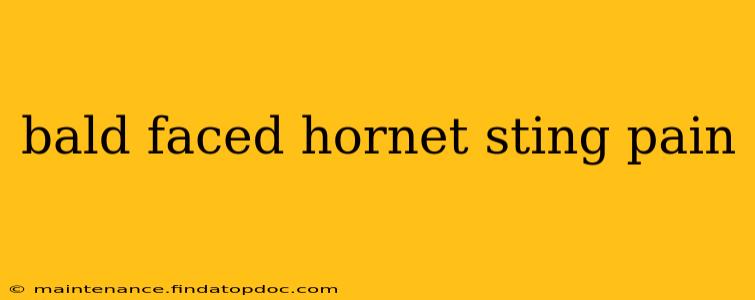The bald-faced hornet ( Dolichovespula maculata) is a common stinging insect across North America, known for its aggressive nature and potent sting. While not as immediately dangerous as some other stinging insects, a bald-faced hornet sting can be incredibly painful and potentially cause serious reactions in susceptible individuals. This article will explore the severity of their sting, potential reactions, and what to do if you're stung.
How Painful is a Bald-Faced Hornet Sting?
The pain of a bald-faced hornet sting is often described as intense, sharp, and burning. Many compare it to a fire ant sting, but often more intense and longer-lasting. The level of pain can vary depending on factors such as individual sensitivity, the location of the sting, and the amount of venom injected. For most people, the pain peaks within the first few minutes and gradually subsides over several hours. However, swelling and redness can persist for much longer.
What Happens After a Bald-Faced Hornet Sting?
Immediately following a sting, you'll likely experience a sharp, burning pain at the sting site. This will be accompanied by:
- Local Reaction: Redness, swelling, and itching are common. The affected area may become warm to the touch. The size of the reaction varies depending on individual sensitivity. Most people will experience a localized reaction limited to the area around the sting.
- Allergic Reaction: A more serious concern is an allergic reaction. Symptoms can range from mild hives and itching to more severe reactions like difficulty breathing, swelling of the face or throat (angioedema), dizziness, and anaphylaxis (a life-threatening condition requiring immediate medical attention). If you experience any of these symptoms, seek immediate medical help.
How long does the pain from a bald-faced hornet sting last?
The pain from a bald-faced hornet sting typically lasts for several hours, although the swelling and redness can persist for a day or two, or even longer in some cases. The duration of the pain and swelling largely depends on the individual's sensitivity and the amount of venom injected.
What does a bald-faced hornet sting look like?
A bald-faced hornet sting site will initially appear as a small red puncture mark, quickly followed by swelling and redness. The area may also become warm and itchy. The severity of the local reaction varies greatly from person to person. Some individuals might only experience minimal swelling, while others might experience significant inflammation extending beyond the immediate sting area.
Is a bald-faced hornet sting dangerous?
While most people will experience only a localized, painful reaction to a bald-faced hornet sting, it's crucial to be aware of the potential for serious allergic reactions. For individuals with allergies, even a single sting can be life-threatening. The venom contains various compounds that can trigger allergic responses, hence the need for vigilance and prompt medical attention if severe symptoms develop.
How do I treat a bald-faced hornet sting?
Treatment for a bald-faced hornet sting focuses on managing pain and preventing infection:
- Clean the area: Wash the sting site with soap and water.
- Ice pack: Apply a cold compress or ice pack to reduce swelling and pain.
- Pain relief: Over-the-counter pain relievers like ibuprofen or acetaminophen can help manage discomfort.
- Hydrocortisone cream: This can help reduce itching.
- Antihistamines: Oral antihistamines can help alleviate itching and swelling, especially for mild allergic reactions.
- Seek medical attention: If you experience signs of a severe allergic reaction (difficulty breathing, swelling of the face or throat, dizziness), seek immediate medical attention.
How to avoid bald-faced hornet stings:
Prevention is always the best approach. Here's how to minimize your risk:
- Avoid nests: Bald-faced hornets are fiercely protective of their nests, so avoid disturbing them. Maintain a safe distance.
- Wear protective clothing: When working outdoors, consider wearing long sleeves, long pants, and gloves.
- Avoid sweet-smelling perfumes and lotions: These can attract hornets.
- Keep food and drinks covered: Hornets are attracted to sugary substances.
- Be cautious around garbage cans: These can attract hornets looking for food.
By understanding the potential severity of a bald-faced hornet sting and taking preventative measures, you can minimize your risk and effectively manage any stings you might experience. Remember, if you experience any symptoms of a severe allergic reaction, seek immediate medical attention.
